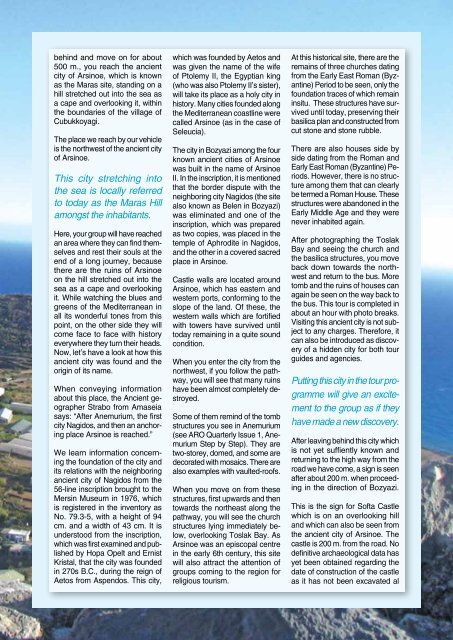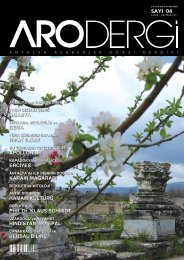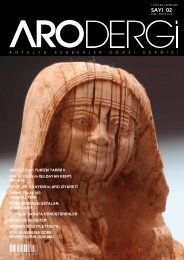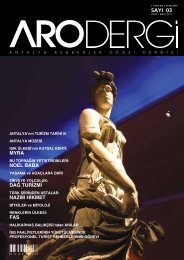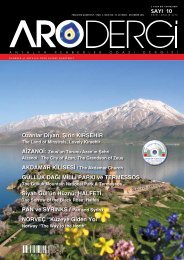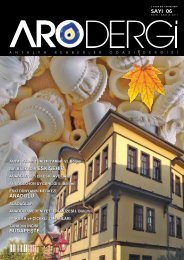Sayı 11- Ocak/Mart 2013 - Antalya Rehberler Odası
Sayı 11- Ocak/Mart 2013 - Antalya Rehberler Odası
Sayı 11- Ocak/Mart 2013 - Antalya Rehberler Odası
- No tags were found...
You also want an ePaper? Increase the reach of your titles
YUMPU automatically turns print PDFs into web optimized ePapers that Google loves.
ehind and move on for about500 m., you reach the ancientcity of Arsinoe, which is knownas the Maras site, standing on ahill stretched out into the sea asa cape and overlooking it, withinthe boundaries of the village ofCubukkoyagi.The place we reach by our vehicleis the northwest of the ancient cityof Arsinoe.This city stretching intothe sea is locally referredto today as the Maras Hillamongst the inhabitants.Here, your group will have reachedan area where they can find themselvesand rest their souls at theend of a long journey, becausethere are the ruins of Arsinoeon the hill stretched out into thesea as a cape and overlookingit. While watching the blues andgreens of the Mediterranean inall its wonderful tones from thispoint, on the other side they willcome face to face with historyeverywhere they turn their heads.Now, let’s have a look at how thisancient city was found and theorigin of its name.When conveying informationabout this place, the Ancient geographerStrabo from Amaseiasays: “After Anemurium, the firstcity Nagidos, and then an anchoringplace Arsinoe is reached.”We learn information concerningthe foundation of the city andits relations with the neighboringancient city of Nagidos from the56-line inscription brought to theMersin Museum in 1976, whichis registered in the inventory asNo. 79.3-5, with a height of 94cm. and a width of 43 cm. It isunderstood from the inscription,which was first examined and publishedby Hopa Opelt and ErnistKristal, that the city was foundedin 270s B.C., during the reign ofAetos from Aspendos. This city,which was founded by Aetos andwas given the name of the wifeof Ptolemy II, the Egyptian king(who was also Ptolemy II’s sister),will take its place as a holy city inhistory. Many cities founded alongthe Mediterranean coastline werecalled Arsinoe (as in the case ofSeleucia).The city in Bozyazi among the fourknown ancient cities of Arsinoewas built in the name of ArsinoeII. In the inscription, it is mentionedthat the border dispute with theneighboring city Nagidos (the sitealso known as Belen in Bozyazi)was eliminated and one of theinscription, which was preparedas two copies, was placed in thetemple of Aphrodite in Nagidos,and the other in a covered sacredplace in Arsinoe.Castle walls are located aroundArsinoe, which has eastern andwestern ports, conforming to theslope of the land. Of these, thewestern walls which are fortifiedwith towers have survived untiltoday remaining in a quite soundcondition.When you enter the city from thenorthwest, if you follow the pathway,you will see that many ruinshave been almost completely destroyed.Some of them remind of the tombstructures you see in Anemurium(see ARO Quarterly Issue 1, AnemuriumStep by Step). They aretwo-storey, domed, and some aredecorated with mosaics. There arealso examples with vaulted-roofs.When you move on from thesestructures, first upwards and thentowards the northeast along thepathway, you will see the churchstructures lying immediately below,overlooking Toslak Bay. AsArsinoe was an episcopal centrein the early 6th century, this sitewill also attract the attention ofgroups coming to the region forreligious tourism.At this historical site, there are theremains of three churches datingfrom the Early East Roman (Byzantine)Period to be seen, only thefoundation traces of which remaininsitu. These structures have surviveduntil today, preserving theirbasilica plan and constructed fromcut stone and stone rubble.There are also houses side byside dating from the Roman andEarly East Roman (Byzantine) Periods.However, there is no structureamong them that can clearlybe termed a Roman House. Thesestructures were abandoned in theEarly Middle Age and they werenever inhabited again.After photographing the ToslakBay and seeing the church andthe basilica structures, you moveback down towards the northwestand return to the bus. Moretomb and the ruins of houses canagain be seen on the way back tothe bus. This tour is completed inabout an hour with photo breaks.Visiting this ancient city is not subjectto any charges. Therefore, itcan also be introduced as discoveryof a hidden city for both tourguides and agencies.Putting this city in the tour programmewill give an excitementto the group as if theyhave made a new discovery.After leaving behind this city whichis not yet suffiently known andreturning to the high way from theroad we have come, a sign is seenafter about 200 m. when proceedingin the direction of Bozyazi.This is the sign for Softa Castlewhich is on an overlooking hilland which can also be seen fromthe ancient city of Arsinoe. Thecastle is 200 m. from the road. Nodefinitive archaeological data hasyet been obtained regarding thedate of construction of the castleas it has not been excavated al


